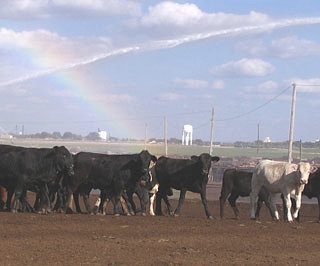Air Quality Issues and Animal Agriculture
Introduction
Air Quality Issues and Animal Agriculture is a significant topic with respect to air pollutant emissions as well as greenhouse gas production that contribute to atmospheric radiative forcing. The present article is a USA-centric treatment of regulatory status of agricultural regulation, chiefly through the vantage point of the U.S. Environmental Protection Agency. Worldwide animal agriculture contributes massive air pollution emissions, with one of the most significant pollutants being methane. Methane is emitted in large quantities from livestock grazing activities, and this gas is not only an air pollutant, but has greenhouse gas potency much higher than carbon dioxide. Animal agriculture is coming under increasing scrutiny worldwide, because the quantites of methane and other air pollutants has been expanding rapidly in the prior decades due to demand from the worldwide human population explosion, and especially practices of overgrazing, in which more animals are allowed to graze a given area than can be sustainably managed.
Summary
From an environmental quality standpoint, much of the interest in animal agriculture has focused on impacts on water resources, because animal waste, if not properly managed, can harm water quality through surface runoff, direct discharges, spills, and leaching into soil and groundwater. A more recent issue is the contribution of emissions from animal feeding operations (AFO), enterprises where animals are raised in confinement, to air pollution. AFOs can affect air quality through emissions of gases such as ammonia and hydrogen sulfide, particulate matter, volatile organic compounds, hazardous air pollutants, and odor. These pollutants and compounds have a number of environmental and human health effects.
Agricultural operations that emit large quantities of air pollutants may be subject to Clean Air Act (CAA) regulation and permits. Further, some livestock operations also may be regulated under the release reporting requirements of the Comprehensive Environmental Response, Compensation, and Liability Act (Superfund, or CERCLA) and the Emergency Planning and Community Right-to-Know Act
(EPCRA). Questions about the applicability of these laws to livestock and poultry operations have been controversial and have drawn congressional attention.
Enforcement of these federal environmental laws requires accurate measurement of emissions to determine whether regulated pollutants are emitted in quantities that exceed specified thresholds. Yet experts believe that existing data provide a poor basis for regulating and managing air emissions from AFOs. In an effort to collect scientifically credible data, in 2005 the Environmental Protection Agency (EPA) announced a plan that had been negotiated with segments of the animal agriculture industry. Called the Air Compliance Agreement, it is intended to produce air quality monitoring data on AFO emissions during a two-year study, while at the same time protecting participants through a “safe harbor” from liability under certain provisions of federal environmental laws. Many producer groups supported the agreement as essential to gathering valid data that are needed for decision making. However, critics, including environmentalists and state and local air quality officials, said that the Air Compliance Agreement would grant all participating animal producers a sweeping retrospective and prospective liability shield for violations of environmental laws, yet because fewer than 30 farms would be monitored, it was too limited in scope to yield scientifically credible estimates of AFO emissions. Some industry groups had their own questions and reservations. In August 2006, EPA approved agreements with 2568 AFOs, representing more than 13,000 farms. Monitoring, involving 24 farms in nine states, occurred from mid-2007 to the end of 2009. In January 2011, EPA released the data from the individual monitored sites. The agency will use the emissions data to develop improved emissions estimating methodologies.
Separately from the monitoring study, in December 2008, EPA issued a rule to exempt animal waste emissions to the atmosphere (Earth's atmosphere) from most CERCLA and EPCRA reporting requirements. Legal challenges to the rule followed. In October 2010, a federal court approved the government’s request to remand the rule to EPA for reconsideration and possible modification.
This report reviews key issues associated with the Air Compliance Agreement. Background information on air emissions from poultry and livestock operations, relevant federal environmental laws and regulations, congressional interest, state activities, and research needs are discussed in CRS Report RL32948, Air Quality Issues and Animal Agriculture: A Primer, by Claudia Copeland.
Editor Note
This summary was taken from the Congressional Research Service Report RL32947 by Claudia Copeland
